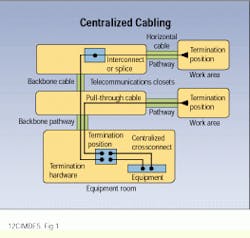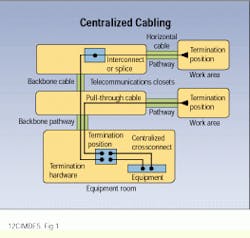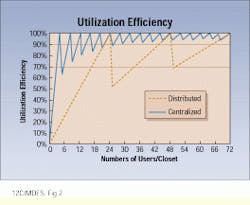Standards facilitate cost-effective fiber-to-the-desk solutions
Centralized cabling makes it possible for network designers to use optical fiber more cost-effectively and to realize a number of other benefits as well.
Tony Beam and Paul Kolesar
Cost has been one of the great obstacles to wide-scale deployment of glass optical fiber to the desktop. However, with the publication of telecommunications systems bulletin tia tsb-72, "Centralized Optical Fiber Cabling Guidelines," network planners can now design more cost-effective horizontal cabling systems that comply with the commercial building telecommunications cabling standard ansi/tia/eia-568a.
TSB-72 lets network designers take advantage of the high bandwidth and low attenuation of 62.5-micron multimode fiber to centralize the electronics of the local area network (lan) in one communications room within a building. Centralized networking using optical fiber offers users the ability to contain--and even reduce--their operating costs, while simultaneously adding flexibility, control, and accessibility to their networks.
Centralized optical-fiber cabling is an alternative to the traditional hierarchical star architecture used when deploying optical-fiber cable in the horizontal because it supports centralized electronics and easier network management. Centralized cabling provides direct connections from work areas to the central crossconnect by using pull-through (home-run) cables--or a splice or interconnect in the telecommunications closet--instead of a horizontal crossconnect.
This approach is not intended to completely replace the use of horizontal crossconnects as specified in tia/eia-568a, but rather to offer a more cost-effective option for those users who want to employ centralized electronics.
To use this new approach in cabling design, network designers must first realize that fiber is not subject to the same distance limitations as unshielded twisted-pair copper cable--and therefore, does not require distributed electronics on each floor. It is also important to understand the conditions under which centralized cabling works to its greatest advantage and to become familiar with the latest industry guidelines supporting the centralized networking administration concept.
Benefits of centralized lan cabling
There are a number of important benefits to centralizing electronics, including initial and long-term cost savings, improved port and chassis utilization, easier network rearrangements, greater security, centralized management, and fewer or smaller telecommunications closets (TCs). Cost savings is perhaps the issue most often discussed; when considering costs, it`s important to look at both installed first costs and the life-time operating costs of a network.
Centralized optical-fiber cabling reduces initial installation costs in several ways. With the longer distances afforded by optical-fiber cable, installers can replace costly horizontal crossconnects with inexpensive pull-through cables, or a splice or interconnect in the TC, while at the same time reducing the need for clean power and environmental conditioning in the closet.
Centralization of lan electronics also provides immediate savings by helping network managers reduce the number of ports and chassis needed for their networks. For example, let`s look at the savings in lan electronics you can expect for a 10Base-F Ethernet network in a building containing six TCs supporting up to 72 work areas per closet and with 24-port hubs. In a network architecture using conventional distributed-electronics design, an average of only 70% of the hub ports will be used, for an effective cost of $214 per user. Using a centralized architecture to serve the same 432 work areas increases hub port usage to an average of 90%, for an effective cost of $166 per user. The 20% improvement in equipment use equates to a savings of $48 per user, based on hub costs of $150 per port. The actual savings realized will vary according to the number of users per closet, the number of closets, and the port capacity of the electronics, but the payback is immediate.
Over the long term, centralized cabling helps reduce maintenance costs and downtime and increases security--glass optical fiber provides more-reliable service, and there are fewer electronics to maintain in far fewer locations. A centralized solution also allows the network manager to establish special workgroup networks at a moment`s notice. Because all users` horizontal cables terminate in a central location, it is easy to patch the electronics required to connect a new workgroup.
Finally, with centralized electronics, you need only one crossconnect facility. This is a real benefit when recabling existing buildings in which closets either do not exist or are not suitable to house distributed electronics. These situations are common in schools, dormitories, factories, and many old or historic buildings. In such cases, centralized electronics often offer the most cost-effective method of cabling or recabling the facility.
Why consider centralization?
Centralized cabling is an attractive architecture for both current fiber-to-the-desk users and those who anticipate upgrading their networks and value the advantages that centralization brings. With proper planning and implementation, this strategy will ensure that the network will remain flexible and manageable over the long term. Driving the deployment of centralized cabling is the desire to realize cost and network management advantages. The network designers to whom centralized cabling is likely to appeal typically need to
- increase control of the corporate network,
- decrease the overall operating cost of maintaining that network,
- have more flexibility in providing networking solutions to individual users.
Often, in such situations, control over and responsibility for the operation of all servers in the network rest with network managers, rather than with individual departments of the enterprise. In many cases, the bridges and routers in the building may have already been centralized to ease administration and improve control. The centralization of data electronics, such as hubs, concentrators, or switches, is a natural progression and extension of this approach.
In terms of building infrastructure, the advantages of centralized cabling are most easily shown for single-tenant buildings, especially those that are owned or under a long-term lease by the building occupant. However, entrepreneurial building owners or third-party network providers may also value the savings in operating costs and the other benefits of centralized networking. In addition, an enterprise occupying a number of floors in a multitenant building is an ideal candidate for centralized networking in its portion of the building.
From the perspective of network demands, centralized optical-fiber cabling provides the greatest benefits to those enterprises that have--or will have--multiple data network technology requirements, such as Ethernet, Token Ring, Fiber Distributed Data Interface, and Asynchronous Transfer Mode (atm), or to operations that have a low density of users per telecommu-nications closet.
What the standard supports
TSB-72 was developed by the Telecommunications Industry Association`s (tia--Arlington, VA) TR-41.8.1 group, the working subcommittee responsible for the ansi/tia/eia-568a standard. This bulletin provides guidelines and recommendations for the proper implementation of a modified cabling topology in support of in-building optical-fiber cabling to the desk. It includes distance limitations, migration-path planning, management information, and optical-fiber cable sizing. The guidelines also address the need for proper planning of the centralized cabling network to ensure its ability to migrate to a horizontal crossconnect in the future if necessary. Requirements for and functionality of the connecting hardware, along with proper installation practices and testing procedures, are also discussed. Among the specific issues covered are:
- Pull-through cable--tsb-72 states that pull-through cables shall not be greater than 90 meters (295 feet) long. Pull-through cables typically are used in smaller structures, such as two- or three-story office buildings. Why limit them to 90 meters? The most important reason is ease of installation. With increased cable-pulling distances, the installation becomes more difficult. Extensive use of pull-through cables can lead to congestion in backbone pathways. In such cases it is better to install high-fiber-count backbone cables and splice or interconnect the horizontal cables to them. tsb-72 also recommends that the total passive link (horizontal and backbone) not exceed 300 meters (985 feet).
- Connecting/splice hardware--Splicing is typically the more cost-effective connectorizing solution for centralized cabling, in part because it requires less space in the closet. However, interconnects allow increased flexibility for network migration and easier troubleshooting for the end-user, especially for those who feel more comfortable with connectors. However, remember that the centralized crossconnect is intended to be the location where all moves and changes are administered. Only the addition or removal of horizontal or backbone links would typically occur in the telecommunications closet.
The requirements for connecting hardware are stated in tsb-72. They ensure that the connecting or splice hardware can be properly administered by allowing for fiber identification and the ability to add or remove fiber circuits. The hardware must also provide for migration to a horizontal crossconnect in the future. Typical outside-plant splice closures will not meet these requirements and are not considered acceptable for this architecture.
Other key considerations
Open-office (zone) cabling--Centralized optical-fiber cabling can be implemented with zone cabling just as it is with traditional single-user cabling. The primary difference is that the horizontal distribution cable is typically a 12- to 24-fiber cable, compared to the normal 2- or 4-fiber cable in single-user cabling. If the splice or interconnect option is used, the backbone cable remains the same, and the multiuser cable is simply spliced or connected to the backbone. For easier administration, the connecting or splice hardware in the TC and the connecting hardware in the central equipment room should allow for organization and administration of the fibers on a per-multiuser-cable basis.
Backbone cable sizing--The intrabuilding backbone sub- system should be designed with sufficient spare capacity to permit additional horizontal circuits to be routed to the centralized crossconnect without needing to pull additional backbone cables. The intrabuilding backbone fiber count should be sized to deliver present and future applications to the maximum work-area density in the area served by the TC. Generally, two fibers are required for each application delivered to a work area.
The most straightforward situation is found in a building in which the horizontal work area is fully cabled with two fibers per user and the building is close to 100% occupancy upon move-in. In this situation, the number of fibers in the backbone cable equals the number of fibers in the horizontal for a given closet.
Some network planners may deploy four fibers to each outlet because of concern that some users may have two separate data-network requirements. Unless most users are expected to require two applications, the number of fibers in the backbone does not have to equal the number of fibers in the horizontal. For example, if a closet serves 100 users and it is believed that no more than 25% of them will require two applications at any one time, the backbone cables should have a total of 250 fibers or 125 drops.
Finally, the situation may exist in which an organization elects to completely cable the horizontal before move-in, while there is a low occupancy rate. In this situation, the network manager can base the number of fibers in the backbone on the initial occupancy rate. In these cases, however, there should be sufficient spare backbone pathway capacity so that additional cable can be placed when the need arises.
On the horizon, look for revised bandwidth requirements that address the latest transceiver technology, expanded link performance recommendations for open-office cabling and centralized optical-fiber cabling, and recommend-ations for the newest generation of connector technologies. q
Tony Beam, registered communications distribution designer (rcdd), of Harrisburg, PA-based amp Inc. and Paul Kolesar of Lucent Technologies in Middletown, NJ, are their companies` representatives to the tia Fiber Optics lan Section (fols). Beam is the director of netconnect systems marketing, and Kolesar is a distinguished member of technical staff and systems engineer for systimax scs. Other members of the tia fols include 3M, Allied Telesyn Interna- tional, Belden Wire & Cable, Berk-Tek, CommScope/General Instrument, Corning, Siecor Corp., SpecTran, and Sumitomo Electric Lightwave.
Centralized optical cabling depends on the greater bandwidth of optical fiber to reduce the need for distributed telecommunications closets in some data-networking scenarios. Interconnects or splices can be substituted for full horizontal crossconnects, or the fiber cable can actually be pulled through to the central equipment room.
Centralized optical cabling is almost always more efficient than a distributed networking scheme at using active electronics efficiently. This is because all electronics are located in a centralized equipment room, where hubs and other devices do not have to be added until existing capacity is fully utilized. With distributed electronics, the hub in one telecommunications closet may only be 40% utilized, while that in another may be 100% utilized, leading to a lower average utilization rate.


